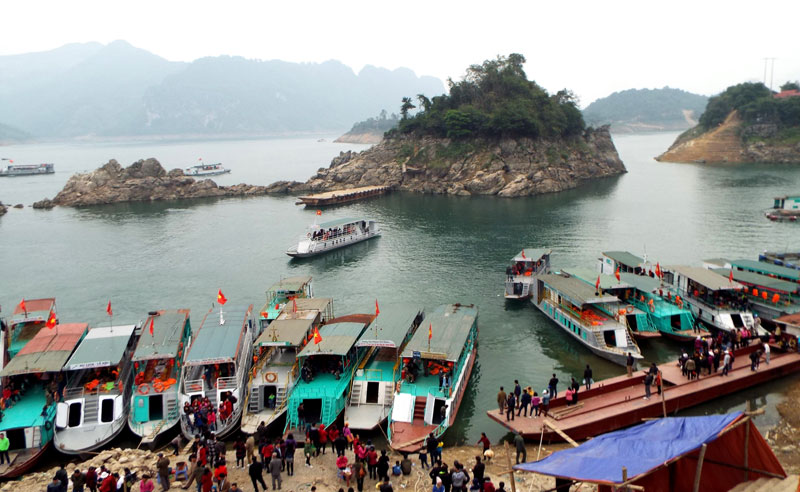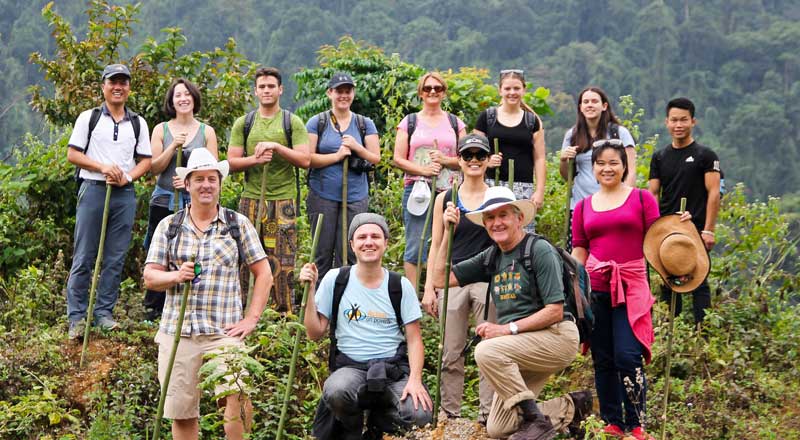
(HBO) – Da River, which runs along imposing mountains and primeval forests and connects Hoa Binh, Son La, Lai Chau and Dien Bien provinces, boasts huge potential to develop cultural, eco and spiritual tourism, thus helping improve local livelihoods. Building tourist attractions along the river is seen as a key task in tourism development.
A series of tourist attractions have been set up around the 600
square kilometre Hoa Binh reservoir which spans residential areas of Mong, Thai
and Lu ethnic minority groups in Lai Chau province. Those include Sin Ho
village with excellent cultural features of Mong ethnic people, King Le Thai To
Temple which was recognised as a national treasure, and Pu Dao commune, lying
at the height of 1,400 metres above sea level with breathtaking natural
landscapes.
Meanwhile, excellent dances and swallow tail boat race can be seen in Muong Lay
commune (Dien Bien province).

Hoa
Binh reservoir has gorgeous natural landscapes with a range of tourist
destinations. Photo: Thac Bo Temple in Thung Nai commune (Cao Phong district)
and Vay Nua commune (Da Bac district).
Hoa Binh reservoir plays an important role in Hoa Binh province’s tourism
development plan. The Prime Minister has approved a master plan to develop the
Hoa Binh reservoir into a national tourism site. Accordingly, studying and
experiencing the culture of the Muong ethnic minority in parallel with the
reservoir’s ecosystem are seen as typical tourism products in the locality.
Community-based tourism has been a magnet for both domestic and foreign
visitors. Famous community-based tourism villages in the province are Ngoi
hamlet in Ngoi Hoa commune; Da Bia hamlet in Tien Phong commune (Da Bac
district), Ke and Sung hamlets (Da Bac), Dua (Coconut) island, Thung Nai (Cao
Phong), Thac Bo Temple in Vay Nua commune (Da Bac).

Foreign
visitors discover tourism route connecting Ke hamlet in Hien Luong commune to
Sung hamlet in Cao Son commune.
The provincial People’s Committees of Hoa Binh, Son La, Lai Chau and Dien Bien along
Da River have preferential policies and mechanisms to attract enterprises,
organisations and individuals to pour investment in local tourism. They should
work to evaluate tourism development potential, form sets of solutions to
implement major tourism infrastructure projects.
Waterway tourism through Hoa Binh, Son La, Dien Bien and Lai Chau provinces,
Hoa Binh-Son La tourism programme and Lai Chau-Dien Bien-Son La tourism
programme must be paid due attention as well.
In the first 9 months of 2024, Hoa Binh province continues to implement the expanded tourism development cooperation program plan of 8 Northwest provinces with Ho Chi Minh City; deploying digital transformation content in tourism and developing a smart tourism province. Hoa Binh province received about 3.6 million views, an increase of 7.9% over the same period. In which, international visitors are about 380 visitors, domestic visitors are estimated at 3 million 220 visitors.
Spanning thousands of hectares and winding gracefully along mountain slopes, hillsides, and riverbanks, the terraced rice fields of Lac Son District present a stunning and captivating beauty. This region, renowned for its remarkable terraced landscapes, is also the centre of Hoa Binh Culture known for numerous archaeological sites.
The life of Mong people in Hang Kia and Pa Co communes of Mai Chau district has improved much thanks to tourism development.
The man-made Hoa Binh Lake, with a water surface area of approximately 9,000 hectares and a capacity of 9.45 billion cubic meters, stretches over 200 kilometers from Hoa Binh to Son La provinces. With the goal of developing into a national tourism area, the Hoa Binh Lake tourism area is expected to not only become the largest tourism centre in the province but also one of the 12 key tourist destinations in the northern midland and mountainous region of Vietnam.
Da Bia hamlet, now Duc Phong, in Tien Phong commune, Da Bac district, was once almost isolated from the outside as the only way to the hamlet was to get a boat ride across the Hoa Binh reservoir. However, as its tourism potential has been unleashed, the hamlet has established itself as one of the most attractive destinations on the tourism map. It has even received the ASEAN Community-Based Tourism Awards in 2019.
In the first 9 months of 2024, Mai Chau district, Hoa Binh province welcomed over 684 thousand visitors to visit and relax. In which, over 516 thousand domestic visitors and more than 168 thousand international visitors. Total revenue from tourism is estimated at over 821 billion VND.




